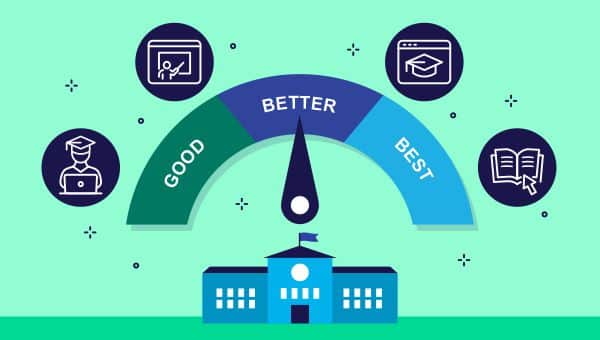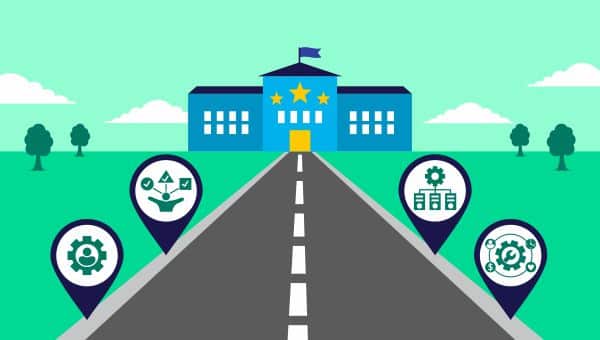Leveraging Staged Growth for Online Learning Infrastructure
When it comes to building a successful online learning ecosystem in higher education, there’s no magic switch to flip — and certainly no one-size-fits-all strategy to follow. For colleges and universities navigating the complex shift to digital, growth isn’t linear. It’s staged. Enter the Good, Better, Best model, one of the most effective techniques an institution can use to grow online.
Unlike blanket approaches that assume every school has the same staff, resources, and readiness level, Good, Better, Best offers a practical, capacity-driven road map — a flexible framework that honors where an institution is while guiding it toward where it wants to go.
At its core, this model isn’t about chasing perfection; it’s about committing to measurable progress over time. “Best” isn’t a static end point. It’s a moving target that evolves alongside the institution’s goals, stakeholders, and capabilities.
At Archer, we view Good, Better, Best not as a ranking system, but as a framework for institutional improvement — one that works only when there’s transparency, alignment, and shared ownership across departments. Whether your institution is just beginning its online learning journey or fine-tuning an established program, Good, Better, Best meets you where you are — and grows with you.
You Might Need a Good, Better, Best Strategy If …
If your institution is experiencing any of the following roadblocks, you may benefit from adopting a Good, Better, Best strategy.
You’re not sure where to start to improve your online operations.
With so many moving pieces — in areas ranging from tech platforms to student support — it can be hard to know what to tackle first. Good, Better, Best helps you identify which areas should be your priority based on capacity, not guesswork.
Your leadership team’s alignment with your long-term goals is unclear.
When leaders aren’t on the same page, it’s easy to spin your wheels. Good, Better, Best creates a common language and plan that fosters alignment across departments and roles.
You’ve outgrown your current partner model and want more control.
If your outsourced solutions no longer fit your evolving needs, Archer’s Good, Better, Best partnership model can help you reclaim ownership of your operational processes with a scalable, strategic framework tailored to your team.
Teams aren’t sure who owns what (and it’s slowing you down).
Role clarity is critical to success. Good, Better, Best surfaces ownership gaps and overlaps so you can streamline your operations and empower your teams to move forward confidently.
You have an institutional vision, but no shared plan to execute it.
Ambition is great — but it needs direction. Good, Better, Best turns a vision into action with clear phases, milestones, and accountability across stakeholders.
You’ve made progress, but need a strategy to maintain it and scale it.
Momentum is hard-won, and sustaining it takes intention. Good, Better, Best supports continuous improvement so you can build on your success without burning out your team.
Why Good, Better, Best Matters in Enrollment Strategy
For institutions looking to grow their online programs, knowing where to go next starts with understanding where they are now.
At Archer, we help colleges and universities assess their current state across the core functions that shape the online student experience — from marketing and enrollment to student support and information technology (IT). Our Readiness Assessment is the first step in building a road map rooted in the Good, Better, Best model.
Rather than applying a rigid, one-size-fits-all playbook, we use Good, Better, Best to create a customized path forward for each institution, shaped by its unique capacity and goals. Each department involved in the assessment — whether it’s admissions, advising, IT, or marketing — gets to define what “Good,” “Better,” and “Best” look like for them.
This is what makes the framework so powerful. It’s not prescriptive; it’s practical and flexible, built around what institutions have today and where they want to grow tomorrow.
By anchoring their enrollment strategy in this kind of honest, department-level reflection, institutions can align their efforts, set realistic goals, and build momentum toward long-term success.
The Challenge of Transformation
In today’s competitive higher ed landscape — where enrollment patterns are shifting and online options are expanding — many institutional teams find themselves overwhelmed. They’re trying to do everything at once, often with stretched resources, siloed decision-making, and no clear sense of what should come first.
The result? Progress that feels more reactive than strategic.
But what’s missing isn’t more effort. It’s more structure.
We’ve seen that the most successful institutions don’t attempt to leap straight to “Best” on day one. Instead, they take the time to map out a clear, achievable path forward. That’s where the Good, Better, Best model makes a difference. It gives teams a way to define their current state, envision their future goals, and understand the phased steps required to get there.
This kind of structured transformation allows institutions to move with purpose — prioritizing what matters most, aligning cross-functional teams, and building momentum one phase at a time.
Is Your Institution Ready for Good, Better, Best?
At its core, the Good, Better, Best model isn’t about doing everything at once — it’s about doing the right things, at the right time, with the right people. It’s a strategic framework that meets institutions where they are and guides them forward with clarity and intention.
At Archer, we don’t just help you design your road map — we walk it with you. As your partner in strategy, delivery, and implementation, we’re here to support you as you achieve sustainable, long-term growth that’s aligned with your mission and built for your team’s unique capacity. With Good, Better, Best, progress isn’t just possible. It’s practical.
Contact us today to learn more.


